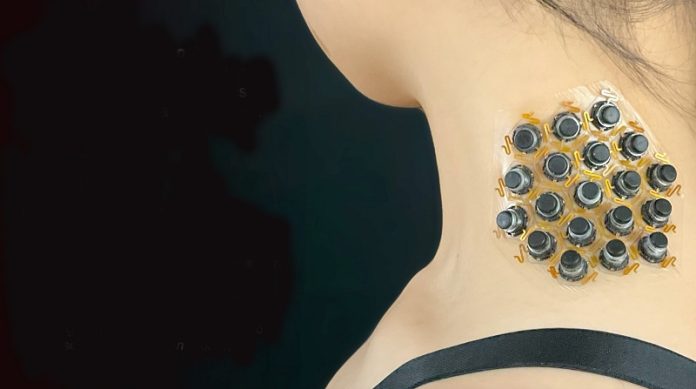
Imagine a small, flexible patch on your skin that can make you feel different types of touch, from gentle taps to twisting motions.
A team of engineers from Northwestern University has developed a new wearable device that does exactly that, providing realistic sensations directly to the skin.
Led by Professor John A. Rogers, this innovative patch offers new possibilities for virtual reality (VR), gaming, and even healthcare.
The patch, made of a thin silicone material, comfortably sticks to the skin and contains 19 tiny magnetic pieces called actuators.
Each one can create various sensations, like vibration, pressure, and a twisting motion, making the experience feel surprisingly lifelike.
The device connects to a smartphone using Bluetooth, allowing it to respond to surroundings and deliver “tactile feedback,” or touch-based information.
For example, someone who can’t see well might feel their way around obstacles using signals from the patch, providing an experience similar to that of a white cane, but with more detailed sensory information.
The idea of “sensory substitution” is central to this technology. In tests, participants wore the patch on their necks and were blindfolded.
As they moved closer to obstacles, the patch’s signals changed, giving stronger sensations that helped them avoid tripping or bumping into things. In a way, the patch substitutes one sense (like vision) for another (touch), giving people a new way to interact with the world around them.
One of the clever features of this patch is how it saves energy. Designed with a “bistable” system, the patch only uses battery power when the actuators change position, storing and reusing energy in the skin itself.
Much like how a rubber band holds energy when stretched, the patch uses the skin’s natural elasticity to reduce power usage. This allows the device to work longer on a single battery charge.
In earlier research, Rogers’ team had created “epidermal VR” technology, which used simple buzzing sensations to mimic touch.
This new device, however, is a major improvement. The miniaturized actuators now provide a broader range of touch-based experiences, from steady force to gentle twists, which adds depth and realism to the sensations.
This breakthrough could be particularly useful in healthcare. People with prosthetic limbs could receive touch-based feedback, and those with vision impairments could navigate their surroundings more safely.
The device shows promise for other uses as well, from enhancing VR experiences to supporting physical rehabilitation.
Overall, this wearable patch is a major step forward in making technology feel more natural, allowing people to “feel” digital information as physical sensations on their skin.
With its mix of creativity and practicality, this device opens up new ways for people to connect with their environment, especially those who might need an extra sensory boost.



